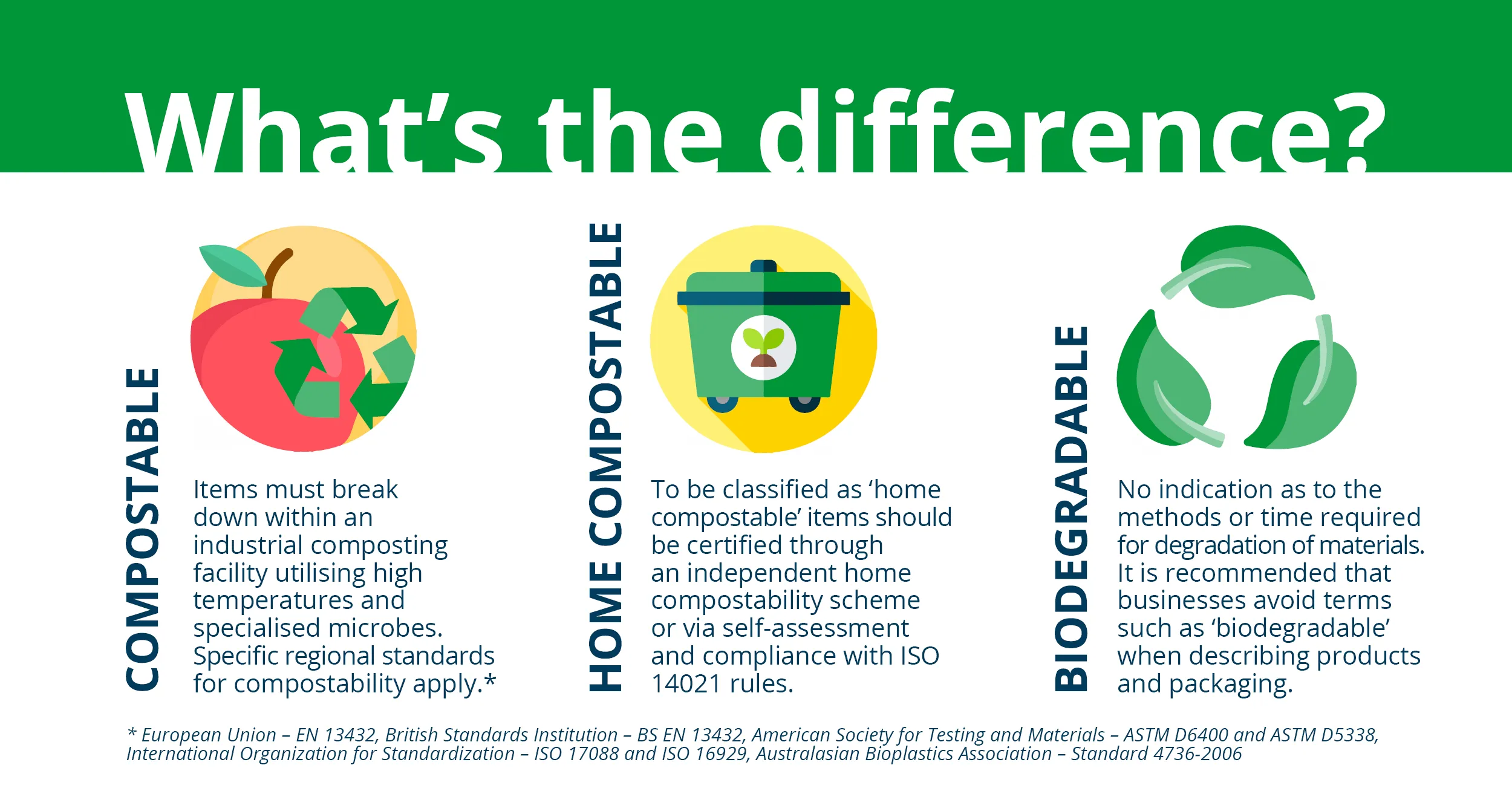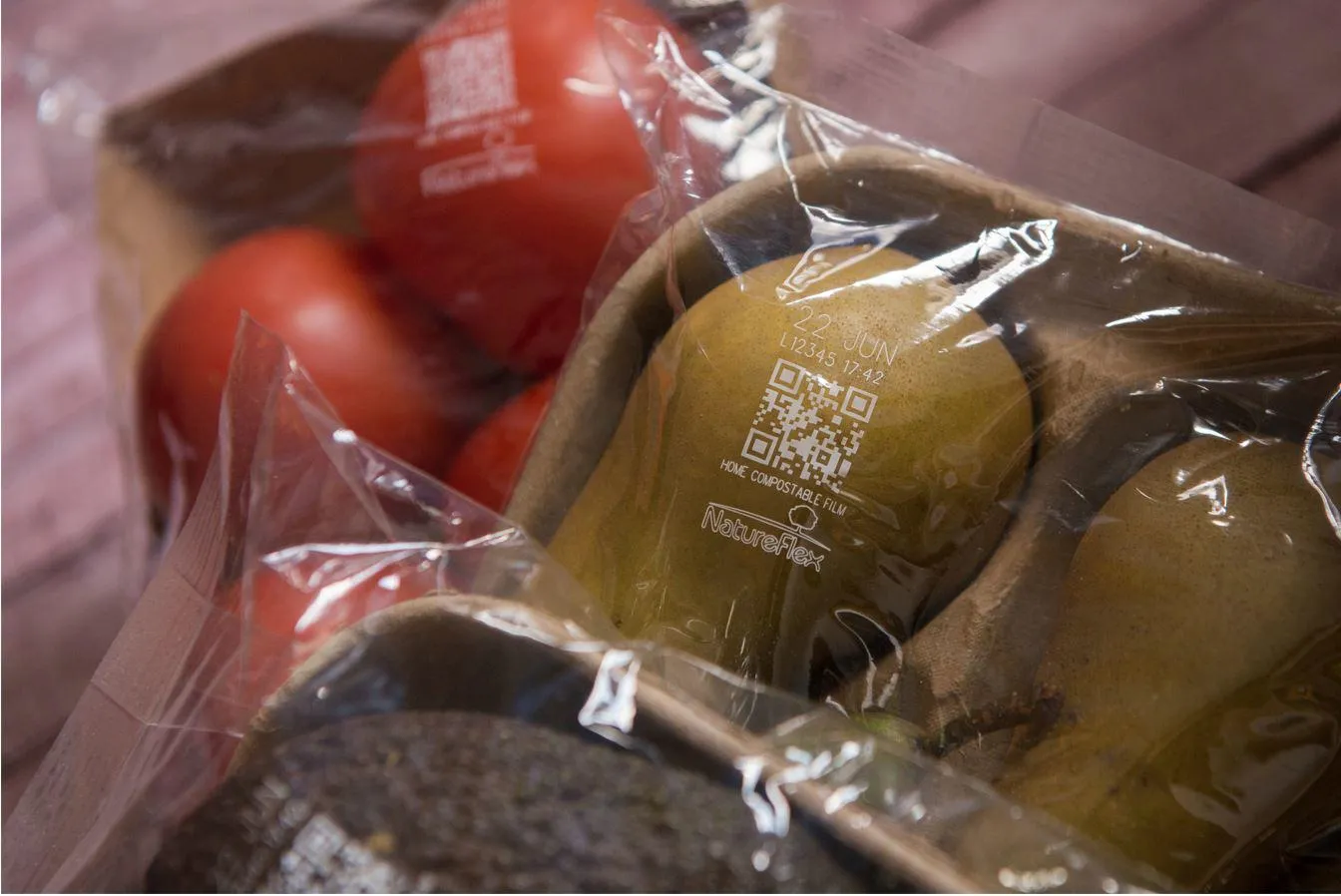Environmental concerns surrounding unrecycled plastic waste have prompted a rise in alternative ‘sustainable’ solutions which look and feel like traditional plastic but can be composted at end of life, helping to combat excess waste.
This sounds great in principle – however, in practice, the solution is not so straightforward, with many now recognising that improper use of compostable plastic packaging could do more harm than good. As with any new packaging material, the use of compostable plastics requires careful consideration.
In our latest blog post on sustainable packaging design, we hope to bring some clarity to discussions surrounding compostable plastics and offer some advice for manufacturers looking to explore new packaging solutions.
In this blog, we speak to Dr. Adam Read, Director of External Affair at SUEZ Recycling and Recovery UK Ltd and President of the Chartered Institution of Wastes Management, and Steve Thomas, Associate Director – Applied Science at Cambridge Consultants, about the issues, and opportunities, presented by compostable plastics.
What do we mean by compostable plastics?

The challenge of compostable plastics
A primary concern with compostable plastic is disposal – if a consumer incorrectly disposes of a compostable plastic container in a recycling bin it can contaminate the recyclable waste around it.
As Dr. Adam Read, Director of External Affairs at SUEZ Recycling and Recovery UK Ltd points out, waste recovery and recycling systems have evolved to manage materials that are commonly used as packaging. Introducing new materials, without careful consideration of existing systems and their ability to flex or adapt, can be problematic, introducing what is considered a contaminant into the mixed recycling stream.
“Materials recovery facilities have been designed to segregate and handle materials that we value and the materials that councils want to recycle – such as PET, aluminium, steel, glass, and card,” he says. “When you introduce new materials there is no guarantee that they will flow as you would expect, or they may inhibit the ability of the system to capture existing target materials.”
“The majority of current systems are designed to recognise different materials by sorting by colour and density – so if a compostable plastic bottle looks and feels like a traditional PET bottle, a recycling system will likely think that it is a PET bottle,” continues Read.
Just a small amount of compostable material can contaminate standard plastic recycling streams leading to the waste of huge quantities of recyclable material. Given these issues, in January 2020, WRAP published new guidance materials to help businesses make informed choices when considering the use of compostable packaging.[i]
“Businesses need to be clear on when it is viable [to use compostable plastics], given the complexities surrounding current treatment infrastructure,” Helen Bird, Resource Management Specialist at WRAP said. “It is critical that end markets for recycled plastics are not compromised; people need clear instruction not to place compostable plastics in the recycling bin.”[ii]
What should be compostable?
For Steve Thomas, Associate Director – Applied Science at Cambridge Consultants, the key to successful use of compostables is in finding those areas where collection and recycling of single-use plastics is problematic, and where it would make sense for a consumer to dispose of something in a food waste bin.
“When designing a product, it is important to consider how you intend for a consumer to dispose of it at its end of life,” he says. “Designing things like PET bottles to be compostable doesn’t make sense, as consumers naturally look to place these into the recycling, which is not a good place for compostable plastics to end up.”
By comparison, hard-to-recycle, heavily food-contaminated items do not currently have an ideal waste stream for disposal. Such items can cause issues when placed in traditional recycling streams and can contribute to methane emissions caused by the anaerobic breakdown of residual food waste if sent to landfill.
The second point here is perhaps the most important to any discussion surrounding compostables – as methane emissions from landfill are a significant contributor to global greenhouse gas emissions, with governments around the world committing to the introduction of mandatory household food waste collections in a bid to curb this.
Upcoming regulations include:
- European Directive (EU) 2018/851 – this directive mandates the introduction of separate collection of food waste as of 1st January 2024 within the EU
- UK Government Resources and Waste Strategy – this strategy pledges the introduction of separate collections for household food waste in the UK by 2023
These upcoming regulations present a huge opportunity for compostable plastic packaging when used in the right way. The following sections identify some scenarios which could be appropriate for businesses to consider the use of compostable plastics to facilitate the collection of additional food waste.
1. Heavily soiled pots, tubs, and trays
One of the most cited situations where compostable packaging could come in useful is with food contact packaging, where the product is heavily contaminated by food waste, and difficult for consumers to clean – such as microwavable ready meal trays.
“There is currently an issue with disposal of these items,” says Thomas. “If a consumer puts them in the recycling there is a risk that they will contaminate other recyclables, or they need to wash them and use a lot of energy and water doing so. For this reason, they are typically sent to landfill.”
A compostable microwavable tray, by comparison, could be placed into a food waste bin in areas where industrial composting facilities exist, or, depending on the material, into a home composter. Any leftover food within the tray would then become compost rather than food waste that is sent to landfill. This would also reduce the number of trays being sent to landfill and improve the quality of recyclables by keeping contaminated products out of recycling bins.

2. Flexible food contact packaging
Flexible plastic wrap is a popular feature in food and beverage applications in everything from single-serve condiment sachets to prepacked, ready-made salads and convenience pouches. However, these materials can be challenging from a recycling perspective.
“Films are a real issue for the sector right now,” says Read. “They stick to things and get tangled up with other recyclables. There are recycling systems in the UK that can handle films, but they are more expensive as a result. Unfortunately, most recycling systems aren’t designed to handle them as most local authorities haven’t historically collected them.”
Compostable plastics could have a role to play here – especially where products are contaminated with food, as in the case of single-serve sachets. In such a scenario, compostable packaging and any leftovers could, again, be disposed of together into a food waste bin for collection and treatment.

3. Items destined for the compost pile
Certain items regularly end up in home compost, or organic waste collection, despite containing conventional, non-compostable plastic. Such items include tea bags, which many consumers incorrectly assume to be entirely compostable, and fruit and vegetable stickers, which are often disposed of alongside fruit and vegetable peelings.
In these instances, where conventional plastics regularly end up in organic waste, it makes sense to switch to compostable alternatives, to improve the quality of the final compost. Interestingly, WRAP highlights teabags as one of the only areas where compostable plastic packaging should always be used in place of traditional plastics because they are regularly placed within the organic waste collection.[i]
Another interesting application to consider is coffee pods. Utilising a compostable alternative to non-recyclable coffee pods would allow for the pod and the coffee grounds to be composted together after use. This would reduce the number of pods being sent to landfill, as well as keep unrecyclable, coffee-contaminated pods out of recycling bins.

Get the labelling right
Ensuring consumer awareness of correct methods of disposal is of the utmost importance when considering the use of compostable plastic solutions. Manufacturers using compostable plastics should ensure that all items are clearly labelled to avoid the risk of compostable materials being disposed of inappropriately, and contaminating the natural environment, or conventional plastic recycling systems.
Considerations should bear in mind the differences in regional recycling systems – for example, when using industrially compostable materials, brands should provide advice on how to dispose of an item in the absence of an industrial composting facility.
WRAP advises that manufacturers should consider labelling which advises consumers on how items should be disposed of, rather than using statements, such as ‘100% compostable’, without disposal information. A list of recommended statements is available from WRAP’s Considerations for Compostable Plastic Packaging.
Where packaging space is at a premium, information could be included within a 2D code, such as a QR or Data Matrix code, to provide easily accessible information to consumers via a smartphone or tablet. The beauty of using a 2D code for applications such as this is that a brand is not limited in the amount of information it can provide.
Utilising standards such as GS1 Digital Link this could be taken a step further, to identify a consumer’s location, and provide personalised information based on their regional recycling capabilities – potentially even linking to the nearest available recycling point.
Domino is here to help
Compostable materials are an exciting new development in the packaging market. However, as with any switch in materials, the use of compostable packaging requires careful consideration.
As an industry leader in the field of coding and marking, we are working hard to advise and support customers during their sustainability journey, to minimise some of the risks involved in designing for sustainability. Our in-house research and development teams are committed to developing coding solutions for a range of new packaging solutions – including compostable materials, and improved recyclable plastics solutions.
At the Domino Laser Academy in Germany, our technical specialists are working to develop solutions for compostable films and heat-resistant packaging. As advances in compostable packaging solutions progress, we will continue our in-house research and development work to ensure that we have solutions to handle the very latest substrates.
If you are considering a switch to compostable materials and would like to discuss the different coding and marking solutions available for your specific needs, please get in touch. We have experts on hand to advise how best to produce products that will be accepted by retailers, valued by consumers, and trusted by everyone with an environmental concern.
[i] WRAP, Considerations for Compostable Plastic Packaging, 2020, accessed 22nd November 2021, https://www.wrap.org.uk/sites/files/wrap/Considerations-for-compostable-plastic-packaging.pdf
[ii] WRAP, New guidance to address confusion of compostable plastic packaging, access 14th December 2021, https://wrap.org.uk/media-centre/press-releases/new-guidance-address-confusion-over-compostable-plastic-packaging#
[iii] WRAP, Considerations for Compostable Plastic Packaging, 2020, accessed 22nd November 2021, https://www.wrap.org.uk/sites/files/wrap/Considerations-for-compostable-plastic-packaging.pdf